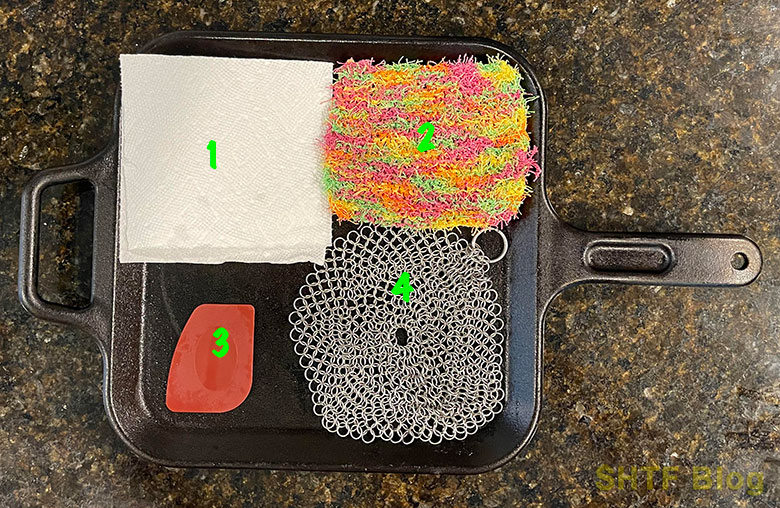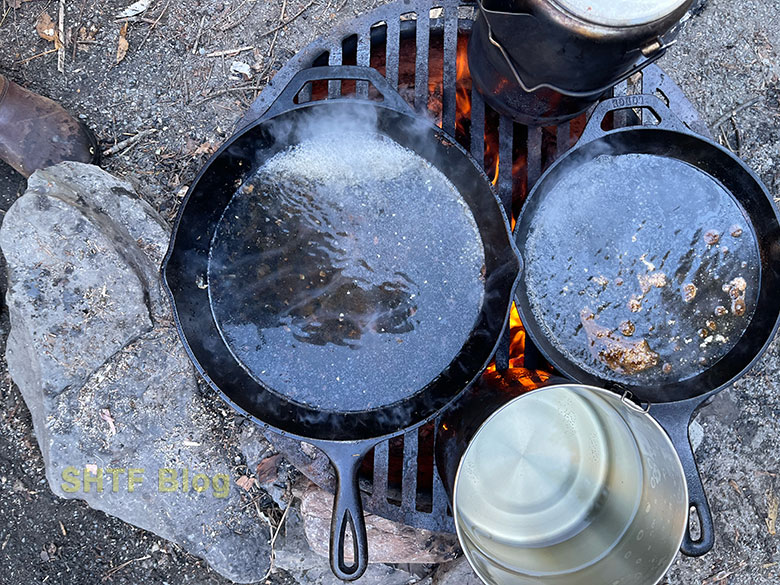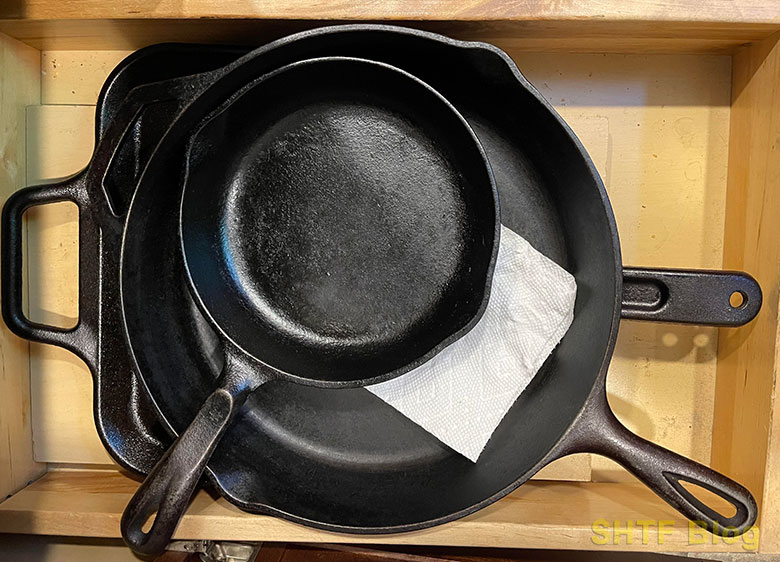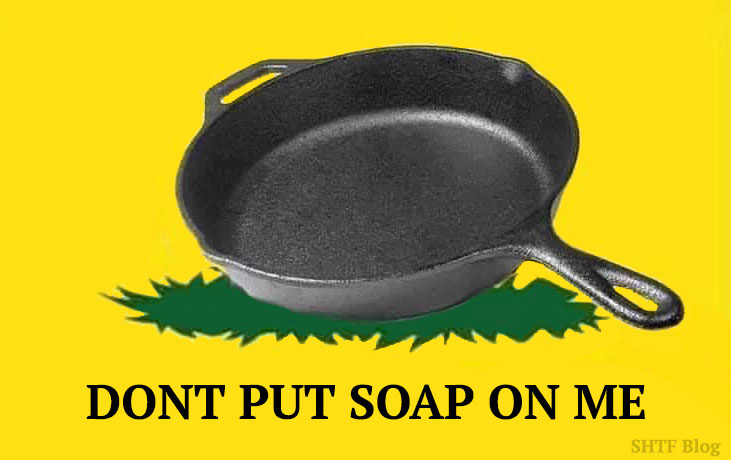
Cast iron is a tough-as-nails cookware material that retains heat well, produces a superior sear, and will last lifetimes – IF you know how to properly clean cast iron. Inexperienced users are usually cast iron cookware’s biggest enemy.
Cooks love cast iron for the qualities it brings to food that other cookware cannot. Preppers, fans of outdoor cooking, and bushcrafters love it for its easy use over open fires. It has a long history of use in the hearth and in the wild.
It’s not difficult to properly care for and clean cast iron, but the process is quite different than other cooking materials. Still, it has its own guidelines to follow to retain its natural nonstick patina in the best possible condition for as long as possible. There are a few simple principles to follow to maintain your cast iron clean and in excellent condition without destroying the seasoning you’ve worked to preserve over time.
At least one study has shown that using a commercial dishwasher will not ruin the seasoning on cast iron, but long-term cast iron aficionados bristle at the idea of putting a cast iron skillet through a dishwasher cycle – myself included.
Before we get into the specifics, it’s important to note that cleaning a cast iron pan takes just a few minutes. You don’t have to give your pan a thorough cleaning after each use. In fact, whenever possible, cleaning should be avoided altogether. For example, if you’ve merely cooked an egg or reheated some chicken breast, a quick wipe of a damp towel should be sufficient.
However, if you’ve just seared something with excess grease or there are stuck-on bits of food hanging out, these steps that follow will ensure that your cast iron stays clean and retains its beautifully seasoned, nonstick surface.
The Benefits of Cast Iron
Cast iron cookware is used in pans, grills, utensils, Dutch ovens, and other cookware. Because of its usefulness, durability, and adaptability, a cast-iron pan is an essential piece of kitchen equipment.
The iron retains heat and distributes it evenly for many sorts of cooking. In addition, cast iron pots and pans are flexible in the kitchen and absorb and retain heat efficiently, making them excellent for recipes that need to be kept warm long after they are served.
Health Benefits
Cast iron does not leach harmful Teflon into your food, unlike contemporary nonstick cookware. Quite the opposite, it adds iron to your food.
Seasoning
But, lest you imagine that the trade-off is that everything adheres to cast iron, cast iron is naturally nonstick if adequately seasoned.
However, most new cast iron pans come pre-seasoned, and the more you cook with fats -oil, butter, lard – the more seasoned and nonstick they become. In fact, I always take “pre-seasoned” cast iron and season it again just the same. The more you season it the better it gets.
Cost
Cast iron cookware is also quite affordable. Yes, a deep Dutch oven designed for an outdoor fire will run you nearly $100, but when you consider its longevity, it is reasonably priced.
- 10-Quart Deep Camp Dutch Oven for campfire or fireplace cooking
- Seasoned cast iron ready to use
- Cast iron lid inverts for use as griddle
- Made in U.S.A.
- Measures 14 inches in diameter and 5 inches deep
Thrift shops and garage sales are great places to discover great deals on cast iron cookware. You can fix and re-season it even if it’s old and rusted.
Aside from being cost-effective and an excellent investment, cooking with cast iron can save you money on soap. This is because soap is not required to clean cast iron. In fact, soap should not be used to clean cast iron since it removes the seasoning.
The Challenges of Cast Iron
Cast iron has been termed the most misunderstood of all the cookware options on the market. As a result, new users will sometimes level accusations against cast iron cookware, ranging from labeling the patina as a chemical coating to accusing businesses of deception because their cast iron cookware corroded.
With that said, some frequent problems cast iron users may face are…
Confusion on How to Clean Cast Iron
When it comes to the best way to clean cast iron, there are many different viewpoints. Some stand with the use of salt, while others stand by specialized metal equipment to maintain their pans in top shape. However, a bit of education can resolve this issue. A bigger priority could be concentrating on how to prevent rust.
Food Clinging to the Surface
Food may adhere to the surface even if you’ve correctly seasoned your cast iron pan. This may occur from a lack of oil in the pan or cooking food with high sugar. New users struggle here as they know they shouldn’t be aggressive with cleaning but aggressive is what’s needed to scrape the food off.
Rust on the Surface
Iron rusts. Seeing rust on the surface of your cookware can give you pause. Should you continue to use it? Is it junk now?
How to Clean Cast Iron Cookware
The importance of knowing how to clean cast Iron cookware cannot be overemphasized. Since the life span and quality depends majorly on cleaning with the proper method. Just a single wrong cleaning can damage the seasoning you have been maintaining and ruin the skillet’s good use, forcing you to begin the seasoning process over again.
The main idea objective to properly cleaning your cast iron skillets is to preserve the seasoning. Although the seasoning might not be easily damaged by heat and methods of cooking, a bad cleaning approach will destroy the cast iron seasoning’s integrity.
The reason cleaning cast iron is unconventional compared to other cookware is because it’s generally advised not to use soap. Soap can reduce the seasoning and surface of the cast iron seasoning over time, depending on the strength of the soap.

The picture above shows the four different cleaning instruments I use: 1) paper towel, 2) soft homemade scrubby, 3) plastic scraper, and 4) stainless steel scrubber. You can use soap on cast iron, but do it sparingly. Never allow the pan to sit in water, and after washing, dry it right away. Rust could develop fast in water.
Light Cleaning
First ask, “Do I need to clean the cast iron at all?” I use my cast iron skillet almost every morning to fry eggs. I never “clean” it after. I just wipe off any remaining egg that didn’t come up with my spatula.

For light cleaning, I use items 1 and 2 in the picture above: paper towel and a soft dish rag. The soft dish rag is handmade by my mother. It’s very soft but has an ever-so-slight abrasive texture to it.
Although some users do not see this as actual cleaning and prefer more intense cleaning techniques, simple wiping with a paper towel in warm water does the job. This guarantees the longest lifespan of the skillet.
Light cleaning does not work for excessive oil stains and food deposits on the pan, however.
Moderate Cleaning
Moderate cleaning should be done with caution since you may still scrape and ruin your seasoned skillet or other cast iron cookware if you are too aggressive. Also, while cast iron is rugged, scars on the surface of the pan might emerge, increasing the danger of rust. This is also the reason for avoiding metal utensils while cooking with cast iron.
For moderate cleaning I use the plastic scraper labeled 3 in the picture above. This is good for when you need a little additional force and also to clean the pan’s exterior. Rinse, look for any lingering debris, and scrub until all of it is removed.
- This upgraded pan scraper has hard smooth plastic edge to scrape the stubborn stains from the pans and smoothly remove food residue from nonstick pans and pots without scratching the surface. It makes dish and cookware cleaning simple and easy!
- The pan scraper tool has 4 different flexible angles. It is quite effective on both curves and flat surfaces of the pans, bowls, dishes, bakeware, and plates.
- This pot scraper is made from food-grade durable plastic, with the optimal grip indentation, non-slip texture and unassuming profile. A hanging hole for convenient storage and portable size for carrying.
- The pan scrapers is dishwasher safe and heat resistant up to 475 ℉. Do not use it at high temperature.
- You can also use this multifunctional kitchen scraper tool to clean the countertops or stovetop, cut cookie or pizza dough, spread icing onto cake, chop avocado and more. It is a must-have cleaning tool in kitchen!
The pan should be well dried after cleaning. People that are serious about their cast iron will then place the cleaned cast iron on a stove burner or over another heat source to assure all water has evaporated. Then they use a paper towel to completely cover the pan’s surface after adding 1/2 teaspoon of high-temperature oil. I only do this some of the time, depending on the severity of the cleaning and the condition of the seasoning.
Deep Cleaning
Sometimes food might get burned onto your skillet leaving to you to wonder how in the world you’ll get it clean. Scraping it with a plastic scraper only goes so far.
One of the best ways to deep clean cast iron is to use a tablespoon of course salt as your abrasive material. Preppers know the advantages to storing course salt, and this is yet another. Salt will help break up the food material making it easier to clean. Place it in lukewarm warm and clean with a kitchen towel, scrubby, or scraper as needed. Then dry it thoroughly.
If the level of good grime is severe enough, I use the stainless steel cast iron scrubber. I try to avoid this, but sometimes it’s necessary. Use as little pressure as possible to get the job done.
Water can be your friend. After you have removed the cookware from the heat, you can add some warm water while it’s still warm (but not scorching hot). That quick simmer will break down a lot of the burnt on food for you. After the hot water has dislodged the food from the pan’s surface, use a wooden spoon or soft brush to remove anything that remains.

Steel wool can also be used to remove burned-on food particles from a very dirty pan. If misused, steel wool can remove the seasoning from your cast iron, mainly if it’s a thin seasoning coating. To avoid this, use steel wool less often since this will enable the seasoning to regenerate quicker than it is pulled off while cooking fatty meals.
- DURABLE & HYGIENIC - Cast iron cleaner is made of restaurant quality 316 grade stainless steel, which is food-safe and ultra-hygienic, unlike conventional germ-infested scrubbers. Chainmail scrubber combines smooth enough and handcrafted and lasts for at least 1 year.
- WILL NOT SCRATCH YOUR PANS - Each ring is handmade with smooth edging for strength and comfort to protect the seasoning of your pans. It will not scratch your pans and keep your cast iron seasoned. It is made of 316L stainless steel with no worries to rust.
- MULTIFUNCTIONAL - Used for cast iron, woks, casseroles, cookware items like a baking sheet, tea pot, cookie sheet, cauldron, tortilla press, cornbread, pie pan and more! A kitchen utensil & gadget Suitable for all kinds of cast iron pan kitchen cookware. Lightweight, and convenient for home, camping or travel.
- EASY TO USE & CLEAN - This iron cast cleaner/cast iron pan cleaner/stainless steel cleaner/cast iron skillet cleaner/cast iron cleaner chainmail scrubber helps to effortlessly clean all your cast iron products and clean up just in 10 seconds when in warm water.
- EASY TO STORE - You can hang it somewhere in the kitchen with no worries about losing it and dishwash safe.We are confident with the quality of the iron cast cleaner.
Some people suggest simmering a small amount of red wine in the skillet over high heat for a few minutes to help remove stubborn bits. Just don’t reduce the wine too much or it too will get stuck on the cast iron.
Also, while using steel wool, attempt to use less elbow grease. The best technique to clean cast iron using steel wool is to apply it softly, just in rough places that won’t come off. Everything else should be sponge-cleaned.

Other Helpful Hints
- A little soap and water may also become necessary at times. Use soap and warm water as an initial wash to get rid of any manufacturing residue or rust particles. After the initial wash, thoroughly rinse and dry the pan. If you take proper care of your cast iron, you should only need to wash it with soap once or twice a year.
- If the cast iron becomes too sticky, sprinkle it with kosher salt – without water – and scrape lightly with a flat-ended wooden spoon or spatula. After that, you can discard the salt and rinse with water.
- Rusting is the most prevalent issue with cast iron, but it is also readily avoided. It is critical to dry your cast iron completely immediately after cleaning.
- Place a pan over low heat for a few minutes to dry it. It will produce some steam and maybe some smoke. When it slows down, your cookware is dry. If the oven is still on, use medium heat to dry the pan. Five minutes at 325 F should be enough.
- Baking soda is a fantastic alternative to soapy dish detergent for cast iron since it deodorizes and kills microorganisms. Baking soda, which has anti-bacterial characteristics, neutralizes smells and aromas from what you’ve just cooked.
How to Clean Cast Iron Outdoors
I use cast iron cookware daily in my home, but where it really shines is outdoors. Cleaning cast iron far from a household kitchen doesn’t have to be rocket science. You again ask yourself – does this even need to be cleaned? Often times you can just heat it up and scrape it clean.
If you need to do more cleaning than a paper towel and a gentle scrape, take your cast iron pan or pot to a river bed and rinse it in sands or light gravel from the riverbed. The gentle abrasiveness of the river sand should do the job.
3 Ways to Fix Rusty Cast Iron Cookware
If you have an old, rusted-out cast iron skillet or Dutch oven, use Coca-Cola to help remove rust. Soak it for a while using equal parts Coke and water.
If your cast iron pan has only accumulated a little rust due to improper drying, your best choice is to brush the rusted areas with steel wool, baking soda, and/or course salt to remove the rust. Steel wool can also be used to remove rust. Repeat the seasoning procedure once the pan is dry if the rusty area is part of the cooking surface.
Another method is to submerge your pan in a solution of equal parts white vinegar and water, but beware of pitting. The vinegar mixture should cover the whole cookware. You may soak it for up to eight hours, but you should check it often. Because the potential pitting is permanent, remove the pan from the soak as soon as the rust peels away easily. If the pan has become so rusty that it is heavily pock-marked or pitted, it is only good as a decorative.
While it’s not a good idea to cleanse a seasoned pan with water and soap, it’s perfectly OK in this case because you’re going to be reasoning it anyway. Use a moderate detergent and warm water to speed up the drying process, then use a gently abrasive sponge to remove any remaining rust.
You’ll need to re-season your pan at this stage. Set the oven’s temperature to 350°F and line the bottom rack with a big piece of aluminum foil. Rub vegetable oil inside and out (it could be any oil with a high smoke point). Then, invert the pan over the foil to collect any drips. Allow it to bake for an hour, then cool for at least 45 minutes before using.
How to Store Cast Iron
Knowing how to store cast iron is as important as knowing how to clean it. Without proper storage your cast iron will rust. I’ve learned this mistake the hard way.

First, ensure the pan is completely dry. You can re-expose clean cast iron to heat to make sure all moisture is removed. Rust will eventually sneak back into the pan if there is extra moisture. Cast iron and moisture do not mix, and incorrectly drying and storing your cast iron can cause it to rust. So keep your kitchenware in a dry spot where it won’t get wet.
You can coat pan with a layer of cooking oil after each use. This will gradually build up an insulating barrier of seasoning, improving the griddle and protecting it from rust. I don’t do this every time, but I do it often.
Using a paper towel to separate nested cast iron pots and pans avoids scratches or damage to the interior of your cookware — and may absorb any moisture that might contribute to corrosion.
The absolute best way to store cast iron skillets is to hang them. This allows plenty of air exposure. This is not always a storage option, however.
If you’re stacking pans, be sure to line each one with a couple of layers of paper towels.
Pans should be kept away from the sink and the stove, where they might be splattered or covered with steam. Dutch ovens should be stored in a dry location with the lids off! Again, you don’t want to trap moisture.
Summary
Cast iron cookware is known to be one of the most vital pieces of equipment in every well-stocked kitchen. Cast iron, known to be almost unbreakable, can be used in practically every location conceivable, from the cooktop to the oven to a bonfire.
Cooking on a cast iron utensil may add substantial quantities of iron to your meal and into your body, a vital nutrient for all your body cells. Cooking in a cast iron pot is a simple method to increase your iron intake in addition to consuming more iron-rich foods like meats, beans, and spinach.
However, cast iron cookware may leak a significant amount of iron into your food, often surpassing dietary requirements. Acidic meals contribute much more leaching, but an old, thoroughly seasoned utensil will leach significantly less iron than a younger one.

The most often asked cast-iron cookware cleaning question is if soap can be used to clean a utensil or grill pan. Yes, you may use soap, but you should it whenever possible. Although a bit of soap will not damage your cast iron, some harsh soaps can destroy the nonstick patina and may change the taste your cast iron has created.



1 comment
Great read! Enjoyed all of the good tips! As far as putting the cast iron pan into the dishwasher, NO, do not do it. My mother had accumulated several cast fry pans. When she finally got her first dishwasher she put a fry pan in to wash it. It cracked the pan and it was now useless. Thinking it was a fluke, she put another one in and it cracked also… We always used a thin metal spatula for cooking and cleaning the pans. No problem. If it was bad stuck food, as you mentioned we would boil water in it then use a “Chore Girl brand” brass scouring pad. We always kept bacon grease and so would coat the pans slightly after cleaning them. My sisters still have those pans today! BTW I am 69 years, so those pans are around 70+ years and still going. Tells you something about how things were made to last in the day!